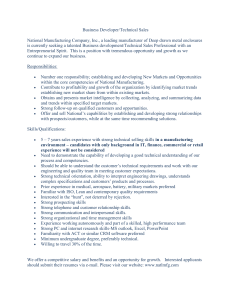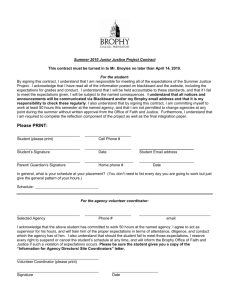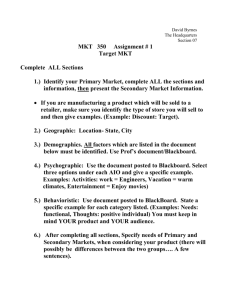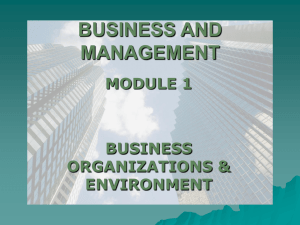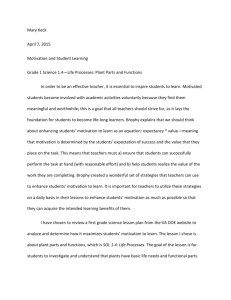Classroom Management - Educational Psychology Interactive
advertisement
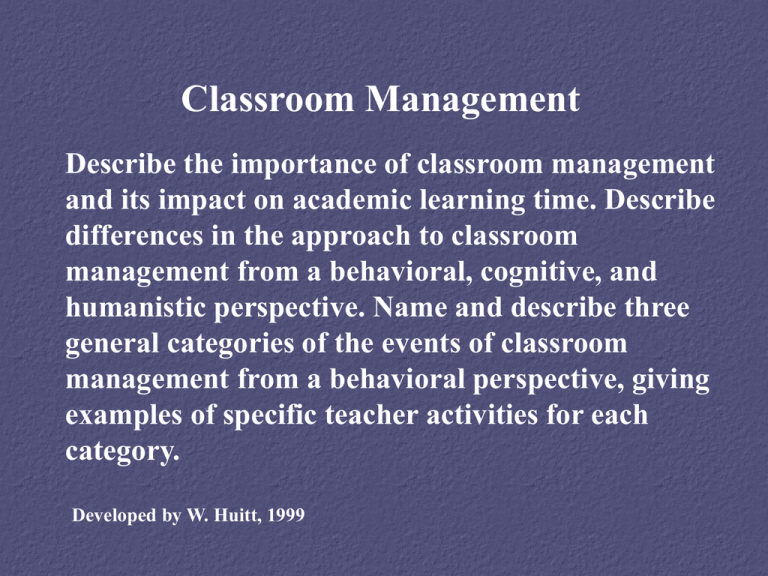
Classroom Management Describe the importance of classroom management and its impact on academic learning time. Describe differences in the approach to classroom management from a behavioral, cognitive, and humanistic perspective. Name and describe three general categories of the events of classroom management from a behavioral perspective, giving examples of specific teacher activities for each category. Developed by W. Huitt, 1999 Classroom Management Primary purpose is to gain control of the classroom Good classroom management results in high levels of student engaged time Classroom Management Brophy (1983) states there are 3 general principles for good classroom management: • Willingness of the teacher to accept responsibility for classroom control • Long-term, solution-oriented approaches to problems (rather than short-term, desist/ control responses Brophy, J. (1983). Effective classroom management. The School Administrator, 40(7), 33-36. Classroom Management Brophy (1983) states there are 3 general principles for good classroom management: • Check to see if symptomatic behavior is caused by underlying personal problems (impulsivity, lack of awareness, home problems, etc.) Brophy, J. (1983). Effective classroom management. The School Administrator, 40(7), 33-36. Classroom Management Brophy (1983) also cites 3 theoretical orientations to classroom management: • Self-concept/personal adjustment -- the teacher encourages discouraged students, builds self-esteem by arranging for and calling attention to success, improving peer relationships, etc. Classroom Management Brophy (1983) also cites 3 theoretical orientations to classroom management: • Insight (cognitive) -- teacher spends time with problem students individually, getting to know them personally, attempting to instruct and inform them Classroom Management Brophy (1983) also cites 3 theoretical orientations to classroom management: • Behavioristic -- teacher offers incentives, negotiates contracts, calls attention to and reinforces desirable behavior Classroom Management This presentation will focus on the application of principles from behaviorial psychology, especially the application of consequences to modify behavior. Behavioristic Approach There are 3 major categories of actions to take in establishing a behaviorally-oriented classroom management program: • Structuring/Selecting and Arranging Activities • Monitor Student Behavior • Reinforce Positive Behavior/ Redirect Inappropriate Behavior Behavioristic Approach Structuring/Selecting and Arranging Activities Establish rules and procedures early Establishing Rules General Recommendations Select 4 or 5 rules that you will use to set guidelines and limits for behavior in your classroom. State the rules in terms of positive expectations of behavior you want to see. Be careful about stating rules in the form of "Don't.” Establishing Rules General Recommendations Think about specific examples of behavior that would demonstrate each rule. Post the rules in your classroom. Teach the rules just as you would academic content using the discussed previously. Establishing Rules Sample Rules For The Elementary Level Be polite and helpful. Take care of your school. Behave in the cafeteria. Do not hit, shove or hurt others. Keep the bathroom clean. Establishing Rules Sample Rules For The Secondary Level Bring all needed materials to class. Be in your seat and ready to work when the bell rings. Obtain permission before speaking or leaving your seat. Respect and be polite to all people. Respect other people's property. Establishing Rules Rules Our Family Uses At Home I will do what I am asked to do without an argument. I will be kind and respectful to my parents and other family members. I will ask permission and accept the decision without getting angry. I will remain calm when I feel angry and talk about how I feel. Behavioristic Approach Structuring/Selecting and Arranging Activities Establish rules and procedures early Establish consequences 1. reinforcers (Premack principle) 2. punishers Establishing Consequences Consequences are environmental stimuli that increase or decrease the probability that a behavior will occur again. We want to establish consequences that will either reinforce or redirect behavior. Rewards and punishers should be selected that match the significance or meaningfulness of the exhibited action. Establishing Consequences Level of Significance Reward Smile Penalty Eye contact Compliment Mild Have student Cheery note on state rule broken assignment Change seats Small amount Isolation of tokens traded Confiscation of for small reward forbidden objects or notes Establishing Consequences Level of Significance Moderate Reward Penalty Posting good work Staying after school Positive note to parents Loss of privileges Special privileges Call to parents Isolation in special room Establishing Consequences Level of Significance Reward Field trips Extensive Recognition at award's banquet Write up in newspaper Penalty Trip to principal's office Loss of special class event (e.g., field trip) Establishing Consequences The most important aspect of delivering consequences is the consistency of delivery. Especially in terms of punishers, any inconsistency might actually increase rather than decrease the probability that the behavior will occur again. Behavioristic Approach Structuring/Selecting and Arranging Activities Establish rules and procedures early Establish consequences 1. reinforcers (Premack principle) 2. punishers Establish method of delivering reinforcers 1. Token reinforcement programs 2. Contingency contract programs Behavioristic Approach Structuring/Selecting and Arranging Activities State expectations clearly Focus on positive expectations Practice "positive" behavior Establish group cohesiveness and responsibility Establish cues Model appropriate behavior Behavioristic Approach Monitor Student Behavior • Physical layout: ability to see all students • Teacher movement: move around the room • Group focus: keep students involved • Overlapping: ability to supervise several activities at once Behavioristic Approach Monitor Student Behavior • Withitness: communicate to students you are aware of what's happening • Pacing/movement management: keep lessons and students moving Behavioristic Approach Reinforce Positive Behavior/ Redirect Inappropriate Behavior • Anticipate occurrence of positive and inappropriate behavior • Hold students accountable • Provide specific feedback regarding behavior and expectations • Focus on positive behavior; teacher attention to inappropriate behavior can be reinforcing Behavioristic Approach Reinforce Positive Behavior/ Redirect Inappropriate Behavior • Effective praise will: 1. be contingent on display of positive behavior 2. specify clearly the behaviors being reinforced 3. be believable by the student Behavioristic Approach Reinforce Positive Behavior/ Redirect Inappropriate Behavior • Methods of coping with inappropriate behavior: 1. Negative reinforcement 2. Satiation 3. Punishment Behavioristic Approach While there are viable alternatives to the behavioristic approach to classroom management, it is clearly the most often used in public schools today. Remember that the long-term goal of any classroom management program is selfmanagement.

